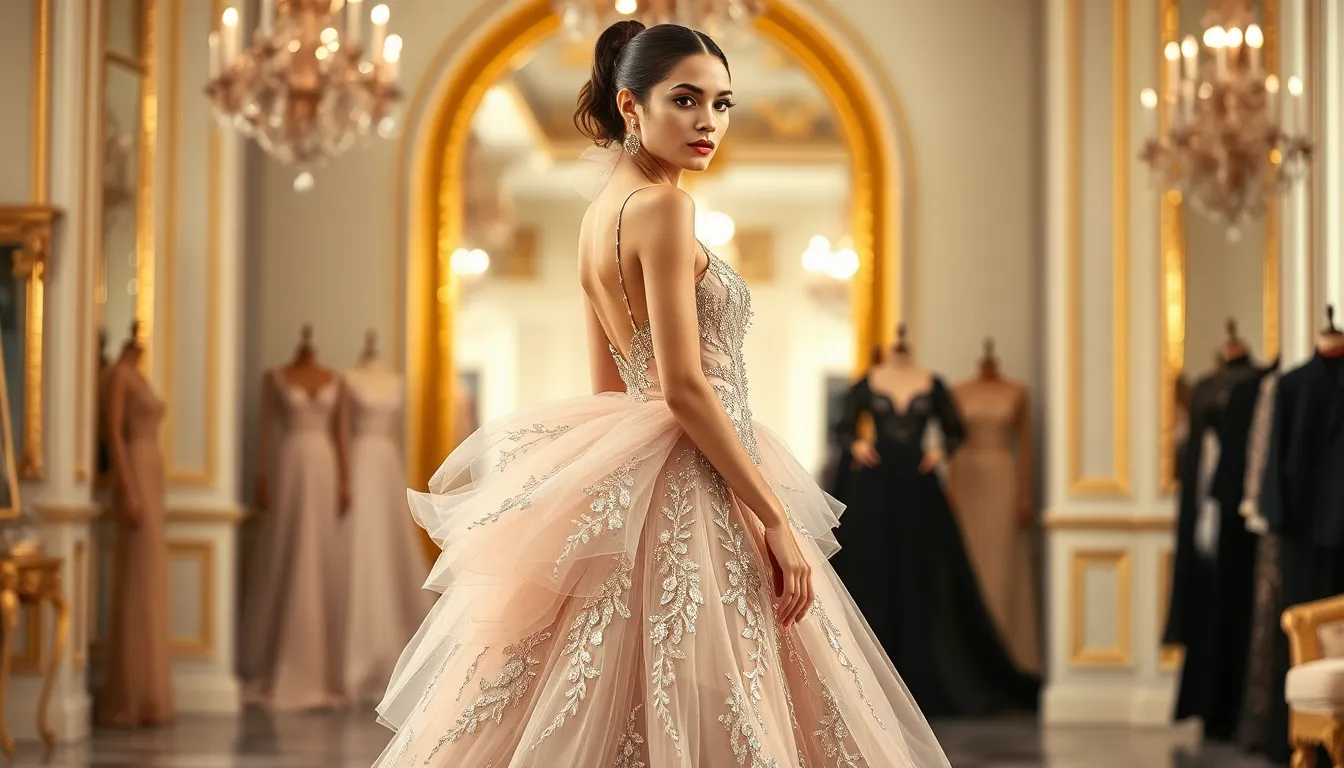In a world where fashion often feels like a game of “who wore it best,” the haute couture aesthetic stands out like a peacock in a flock of pigeons. This exclusive realm of fashion isn’t just about clothing; it’s a dazzling celebration of creativity, craftsmanship, and a sprinkle of fabulousness that makes heads turn. Imagine garments that are more art than attire, tailored to perfection and dripping with luxury.
Haute Couture Aesthetic
Haute couture aesthetic encompasses the artistry and exclusivity of fashion that transcends mere trends. It highlights an extraordinary level of skill, creativity, and attention to detail.
Definition and Origins
Haute couture refers to high-end fashion that is custom-made for individual clients. Officially recognized by the Chambre Syndicale de la Haute Couture in Paris, the term originated in the mid-19th century. Charles Frederick Worth, often considered the father of haute couture, established this concept with his lavish, meticulously crafted designs. This fashion genre emphasizes prestigious craftsmanship, often utilizing the finest materials. Clients seek these exclusive garments for their uniqueness and personal tailoring, which contributes to the allure of haute couture.
Key Characteristics
Haute couture pieces boast distinct features that set them apart from ready-to-wear collections. Craftsmanship stands at the forefront, as each garment typically involves over 1,000 hours of labor. Fabrics used in haute couture include silk, tulle, and wool, enhancing visual and tactile appeal. Design characteristics often incorporate elaborate detailing, such as hand-embroidery and intricate embellishments. Additionally, exclusivity plays a crucial role; only a limited number of items are produced, elevating their desirability. Fashion houses emphasize personalization, tailoring garments to fit the client’s specific measurements and preferences.
Elements of Haute Couture Aesthetic

Haute couture aesthetic showcases exquisite details and luxurious elements that define high fashion. The artistry involved reflects masterful craftsmanship and unique materials, resulting in garments that blur the lines between fashion and art.
Fabrics and Textures
Fabrics like silk, tulle, and chiffon represent the foundation of haute couture garments. Silk drapes elegantly, offering a soft sheen that enhances any design. Tulle introduces volume and richness, perfect for layering or creating dramatic effects. Chiffon adds a lightweight touch, providing fluidity and movement. Various textures, such as brocade or jacquard, contribute depth and visual intrigue. Hand-embroidered elements further elevate the aesthetic, incorporating intricate beadwork and embellishments. Each fabric and texture interplay creates a sensory experience, showcasing the luxury associated with haute couture.
Silhouettes and Shapes
Silhouettes and shapes in haute couture fashion emphasize creativity and individuality. Dramatic ball gowns capture attention with their voluminous skirts, while structured tailoring defines the waistline and enhances femininity. A-line designs flatter a variety of body types, making them widely popular. Contemporary silhouettes may include asymmetrical cuts, drawing the eye in unexpected directions. Capes may replace traditional sleeves, offering elegance and allure. Each shape serves to accentuate the wearer’s unique qualities, illustrating the bespoke nature of haute couture.
The Role of Designers in Haute Couture
Designers embody the essence of haute couture, bridging artistry and technical skill. These creatives transform fabric into wearable art, showcasing their unique visions through each collection.
Influential Designers
Several designers have significantly shaped haute couture over the decades. Christian Dior revolutionized the silhouette with his “New Look,” emphasizing femininity and elegance in post-war fashion. Coco Chanel introduced iconic pieces like the Chanel suit, blending comfort with style. Additionally, Yves Saint Laurent pioneered ready-to-wear collections, making high fashion accessible. Each designer contributes a distinct voice, establishing trends that resonate through the industry.
Design Processes
The design process in haute couture involves meticulous planning and execution. Designers start with conceptual sketches, translating creative ideas into tangible garments. Fabric selection follows, focusing on luxury materials such as silk, tulle, and lace. Craftsmanship plays a critical role, with skilled artisans dedicating hours to techniques like draping, hand-embroidery, and tailoring. Each piece is custom-fitted, ensuring an impeccable fit that enhances the wearer’s silhouette.
Haute Couture Aesthetic in Modern Fashion
Haute couture continues to inspire and influence contemporary fashion, merging artistry with technical design.
Trends and Adaptations
Fashion houses often reinterpret haute couture elements in modern ways. Designers incorporate luxurious textiles and intricate detailing to create pieces that capture the essence of haute couture while appealing to a broader audience. Oversized silhouettes, sustainable fabrics, and eclectic patterns appear as trends, merging tradition with modernity. Numerous designers now feature asymmetrical cuts, offering fresh takes on classic shapes. Seasonal collections frequently showcase these adaptations, allowing haute couture aesthetics to evolve within the ever-changing landscape of fashion.
Influence on Ready-to-Wear
The impact of haute couture on ready-to-wear collections is evident throughout the industry. Designers leverage techniques and aesthetics from haute couture to enhance their mass-produced garments. Signature elements from haute couture, including tailored silhouettes and luxurious materials, often filter down to accessible fashion lines. The fusion of artistic creativity with practical wearability transforms everyday clothing into elevated styles. Influential designers consistently bridge the gap, making haute couture’s grandeur available in ready-to-wear formats. This accessibility not only democratizes fashion but also keeps the spirit of haute couture alive in the mainstream.
Conclusion
The haute couture aesthetic stands as a testament to the pinnacle of fashion artistry and craftsmanship. It’s a world where clothing transcends utility and becomes an embodiment of creativity and individuality. Each piece tells a story of meticulous attention to detail and luxurious materials, captivating those who appreciate the finer things in life.
As haute couture continues to influence modern fashion, it inspires designers to blend traditional techniques with contemporary styles. This evolution ensures that the essence of haute couture remains relevant, breathing life into both high-end and ready-to-wear collections. The allure of haute couture will undoubtedly continue to shape the fashion landscape, inviting admiration and aspiration for generations to come.




